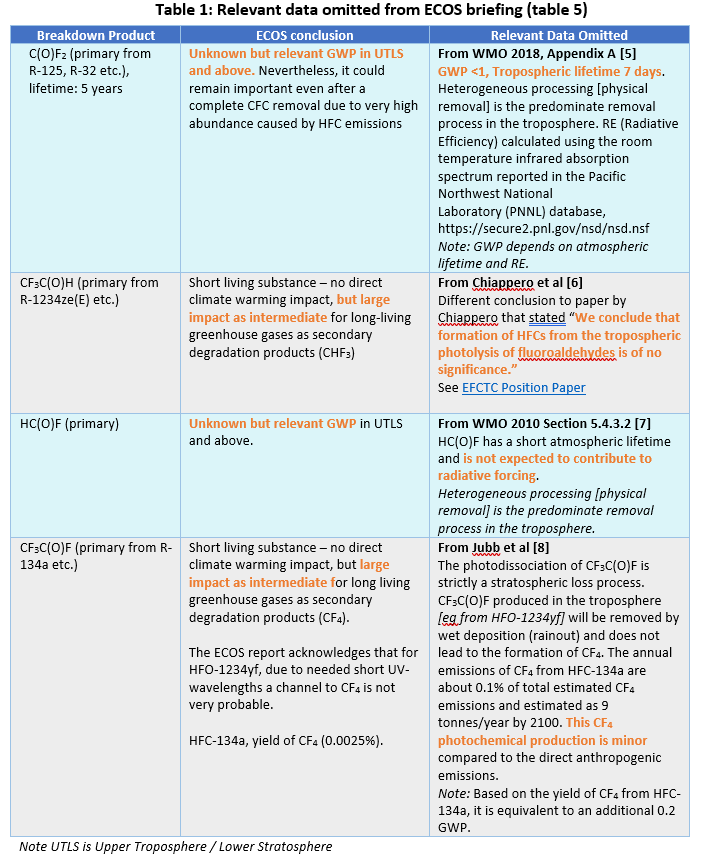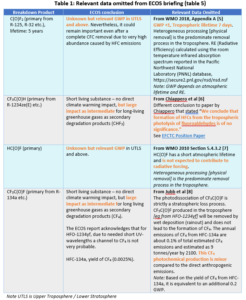ATMOSPHERIC BREAKDOWN PRODUCTS OF HFCs AND HFOs- Relevant data omitted from ECOS report
In its briefing, publicised at the May F-gas stakeholders meeting, ECOS [1] discussed the life cycle impact of refrigerants, and specifically, the additional impact of the degradation that refrigerants undergo once emitted into the atmosphere. There are some highly relevant publicly available data that has been omitted from the ECOS briefing.
 The ECOS briefing in its summary table [2] of the atmospheric breakdown products states that GWPs of primary and secondary or even final degradation products are taken from all WMO reports [3] as well as Hodneborg et al. [4] Relevant data that has been omitted from the ECOS briefing is summarised in Table 1.
The ECOS briefing in its summary table [2] of the atmospheric breakdown products states that GWPs of primary and secondary or even final degradation products are taken from all WMO reports [3] as well as Hodneborg et al. [4] Relevant data that has been omitted from the ECOS briefing is summarised in Table 1.
Hydrocarbon refrigerants indirect GWPs: For completeness, it is worth noting that hydrocarbon refrigerants have an indirect GWP effect. For the non-methane hydrocarbons (NMHCs) the main contributors to indirect GWPs are through tropospheric chemistry interactions, methane concentrations increase when the hydroxyl radicals are consumed by the more reactive organic compounds emitted during anthropogenic activities. The photochemical production of ozone, also a greenhouse gas, is also enhanced by an increased burden of NMHCs.[9] The hydrocarbon GWPs [10] have an indirect GWP component accounting for over 99% of the total GWP for propane and butane and over 95% for ethane. Their direct and indirect GWPs are shown in Table 2.
References
[1] ECOS Briefing: One step forward, two steps back A deep dive into the climate impact of modern fluorinated refrigerants May 2021
[2] ECOS Briefing Table 5
[3] All reports on Scientific Assessment of Ozone Depletion, World Meteorological Organisation, 1994-2018, URL: https://library.wmo.int/
[4] Hodnebrog, Ø., Myhre, G., Kramer, R. J., Shine, K. P., Andrews, T., Faluvegi, G., Kasoar, M., Kirkevåg, A., Lamarque, J.-F., Mülmenstädt, J., Olivié, D., Samset, B. H., Shindell, D., Smith, C. J., Takemura, T., Voulgarakis, A.: The effect of rapid adjustments to halocarbons and N2O on radiative forcing, npj Climate and Atmospheric Science, Issue 3, 2020, Pages 1 ff., DOI: https://doi.org/10.1029/2019RG000691
[5] WMO (World Meteorological Organization), Scientific Assessment of Ozone Depletion: 2018, Global Ozone Research and Monitoring Project–Report No. 58, 2018.
[6] Malisa S. Chiappero, Fabio E. Malanca, Gustavo A. Arguello, Steven T. Wooldridge, Michael D. Hurley, James C. Ball, Timothy J. Wallington, Robert L. Waterland, and Robert C. Buck J. Phys. Chem. A 2006, 110, 11944-11953, Atmospheric Chemistry of Perfluoroaldehydes (CxF2x+1CHO) and Fluorotelomer Aldehydes (CxF2x+1CH2CHO): Quantification of the Important Role of Photolysis.
[7] WMO (World Meteorological Organization), Scientific Assessment of Ozone Depletion: 2018, Global Ozone Research and Monitoring Project–Report No. 52, 2010.
[8] Jubb, A.M., McGillen, M. R., Portmann, R. W., Daniel, J. S., Burkholder, J. B.: An atmospheric photochemica l source of the persistent greenhouse gas CF4, Geophys. Res. Lett., Volume 42, 2015, Pages 9505-9511, DOI: 10.1002/2015GL066193.
[9] IPCC/TEAP Special Report: Safeguarding the Ozone Layer and the Global Climate System page 163
[10] Lifetimes, direct and indirect radiative forcing, and global warming potentials of ethane (C2H6), propane (C3H8), and butane (C4H10), Atmos. Sci. Lett. 2018;19:e804. wileyonlinelibrary.com/journal/asl2 https://doi.org/10.1002/asl.804 Øivind Hodnebrog, Stig B. Dalsøren, Gunnar Myhre, Center for International Climate and Environmental Research-Oslo (CICERO), Oslo, Norway

